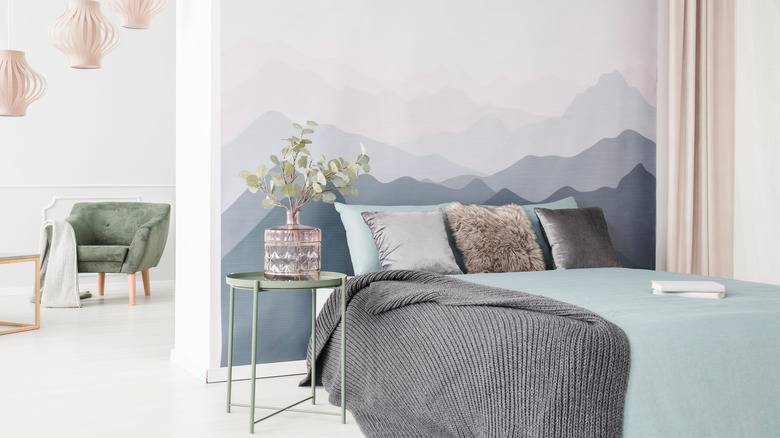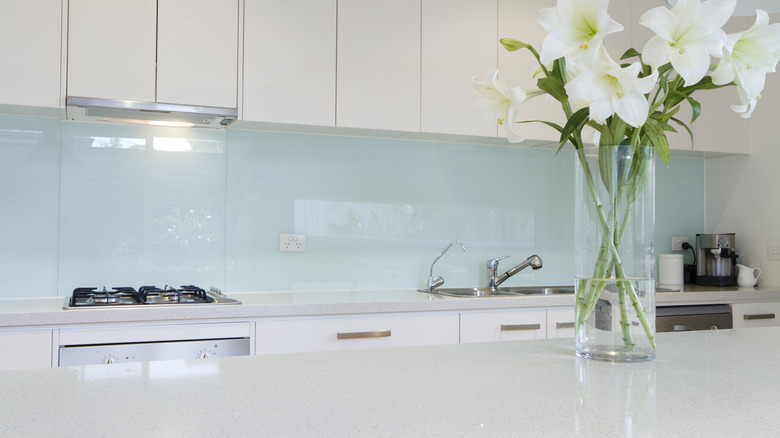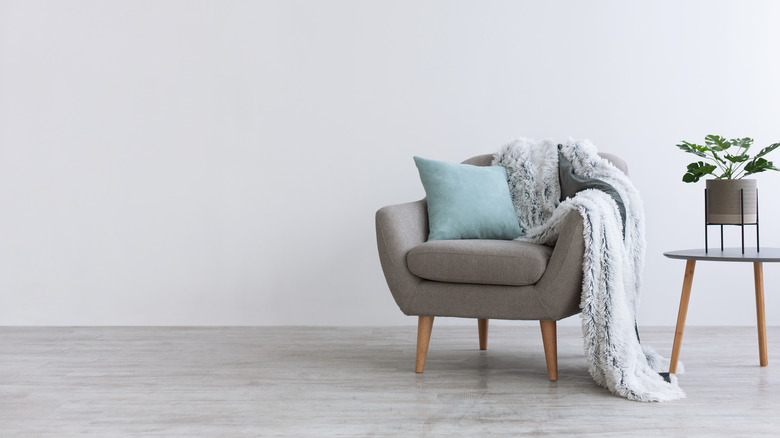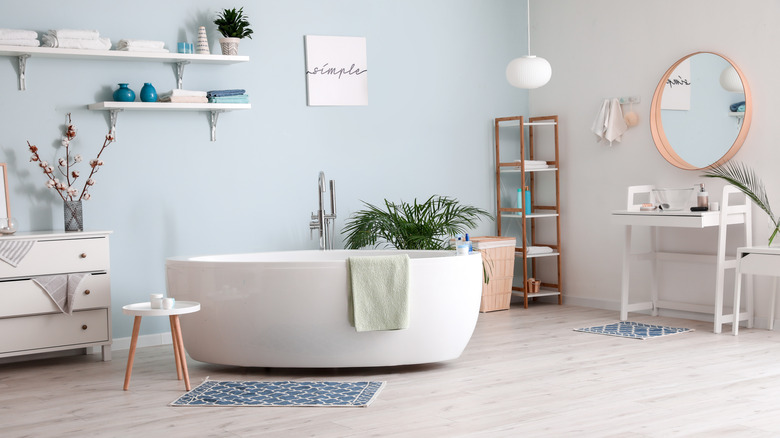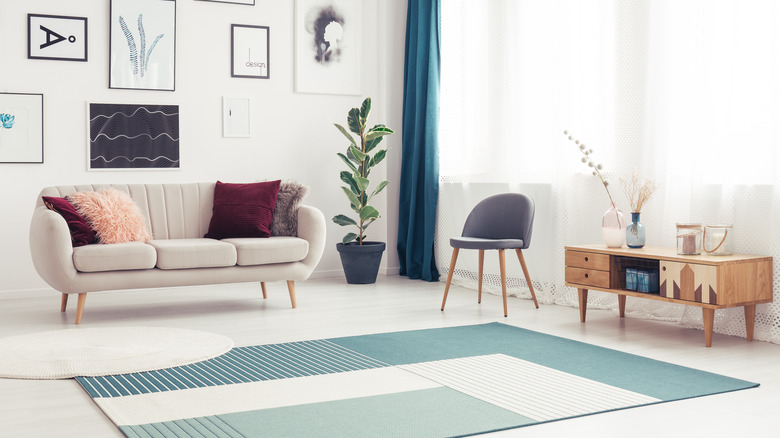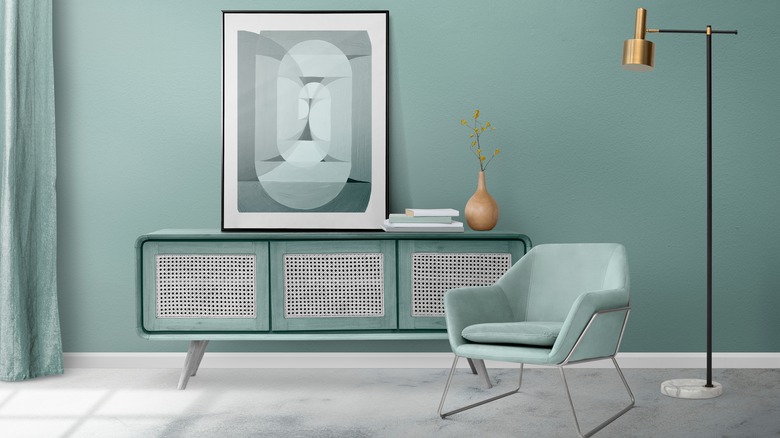5 Ways To Incorporate Pale Blue Into Your Home Decor
Pale blue is an incredibly versatile color. It evokes both the sea and the sky, making it a beautiful accompaniment to nature-inspired palettes. In its lightest varieties, it can almost display as a slightly cool-toned icy white. As a color inspired by nature, pale blue can easily share in any natural color palette that incorporates greens, earth tones, and neutrals. The lightest blue can also shine as a pastel alongside other soft shades of lilac, yellow, and blush pink.
Because of its adaptability, pale blue itself can sometimes be considered neutral, according to Gray Malin, and looks amazing paired with natural materials like wood, marble, and stone. It's often found equally in the company of bright oranges and mustard yellows. To bring in a little or a lot of this calming, fresh shade, there are a number of ways to do it well, including where to use it in your home and how.
1. A relaxing kitchen
Blue is a calming color in any intensity of shade, and pale blue fulfills this function even more, which is why it is a great option for kitchen walls or backsplashes. According to Veranda, a soft pale blue pairs extremely well with other natural elements you may find in countertops and cabinets, like various kinds of wood, stones, and other finishes. Even crisp white modern cabinets stand out stunningly against a light blue background.
Consider pale blue as an option for your kitchen, particularly warmer shades like pale aqua. It's a color that's perfect for vintage-inspired spaces as well, where it's often paired with other pastels or bright red. Combine soft blues with pale shades of green for a beautiful sea-glass-inspired space with blue and green glassware on display. Soft blue can complement almost any home design scheme, including modern, cottage, beachy, or farmhouse décor. If your kitchen is neutral, pale, or barely-there blues, add a variation in tone that does not call too much attention to itself.
2. Paired with neutrals
A wonderful accompaniment to any neutral décor scheme is pale blue. It goes well with a number of neutral shades, where it evokes a sense of both sky and sea. Pale blue pairs beautifully with grays in particular but also works lovely alongside beiges, khakis, and browns. According to Leaf, pairing soft blue with neutrals gives an immediate sense of tranquility to any space.
For warmer spaces, choose a pale, sea-washed aqua with creme or white upholstery and furnishings. For a modern, sophisticated look, add a lighter slate blue that borders on grey for a cooler touch. If you are using blue as a neutral, pair it with wood and other natural materials like stone and bamboo. Because it's a color that is associated with the water or sky, it also pairs well with shades of green that you find in the trees and grass. For more dramatic interiors, combine deep browns and light blues in rich materials like satin and velvet for instant elevation.
3. A bathroom oasis
If you are looking for the perfect color for your bathroom, consider a pale blue accent wall. Here, it's paired with white furniture and accents in other shades and intensities of this adaptable color. Like in the kitchen, blue has a calming effect that's perfect for spaces you go to kick back and relax. According to Indigo Alley Interiors, looking at shades of blue lowers the pulse and contributes to a sense of well-being.
You can use a little or a lot of blue in your bathroom to get a spa-like effect. It works well especially combined with green, to offer an earthy oasis. It also looks stunning with white porcelain fixtures. Combine it with natural materials and neutrals to make your home feel like a luxury spa. Options include icy cool blues and warmer tinted aquas that approach green. Shades of pale blue also work beautifully as an accent color for towels, accessories, and other décor items in neutral spaces.
4. With other colors
Because of its versatility, you can combine pale blue with numerous other color options and still have it work out stunningly. Here, two shades of blue and white on a modern, contemporary rug complement the clean lines of mid-century modern pieces. The neutral couch is augmented by burgundy and peachy pink throw pillows and darker teal drapes. The colors, while not close in relation, still work together due to the adaptability of the blue.
Because blue can be considered neutral, the sky is the limit when it comes to matching other colors in your décor. Blue looks equally attractive alongside warm colors like orange and yellow, as well as cooler-toned shades like green and gray. Canva suggests combining light blues with a number of colors, including lilac, lavender, dusty rose, and peach, for great results. Soft blue also pairs well with other soft pastels like pink and mint green.
5. Layering blues
Blue is a phenomenal color to choose if you are thinking of layering various shades of a single color for a monochrome effect. Since it's a pervasive color throughout the design world, finding an abundance of perfect shades is much easier than attempting to do so with more complicated colors like orange and yellow. Varying shades of depth can be easily found in décor elements, whether it's icy blues or warmer-toned aquas with notes of cream.
According to Emily A. Clark, layering shades of a color like blue is a beginner-friendly tactic if you are worried about matching colors. Consider pairing rich indigo or navy with a pale, barely there blue. Or dark teal with soft aqua. Deeper, brighter shades of blue match well with lighter variations of the same tone. Because they are in the same family, these shades are perfect for even the most color-shy homeowners.
